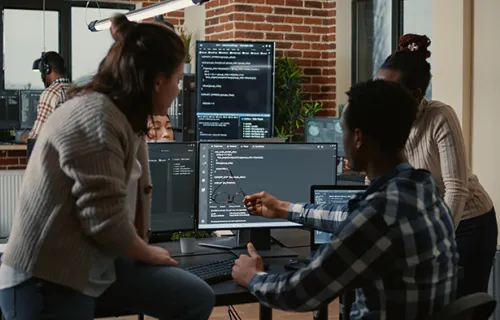Employees working outside of governance and IT oversight account for an increasing amount of technology development within federal agencies.
There is value in what they produce, but there is also risk. To leverage their value and protect the organization, government leaders are beginning to employ organizational change management (OCM) to put governance guardrails in place and turn these resourceful employees into official citizen developers.
Passion and urgency fuel much of the rising tide of unauthorized technology development. Individuals who are passionate about their work are increasingly creating one-off solutions to help them to do their jobs better. Others, finding certain tasks unnecessarily laborious and time-consuming, create tools that accelerate their contributions.
Agency IT departments are often stretched to the max and lack the bandwidth to respond to all the demand for such tools. The lack of IT support leaves employees to build these tools, called locally developed applications (LDAs), outside IT protocols.
Related: Approaching low-code like the cloud
Related: Bringing 'shadow IT' into the light
These individuals may include some of your most committed, ambitious employees, highly skilled at their own jobs. Your challenge is to harness, and enhance, the work of these citizen developers using OCM. A governance program with a strong OCM foundation will channel their efforts into developing these solutions in a controlled manner under your governance and IT protocols.
Agencies should prioritize supporting and scaling the work of citizen developers, striving for a high and consistent level of quality across the enterprise. Their work product should be compatible with the agency’s overall IT infrastructure. Citizen developers need to take compliance as seriously as they do utility and incorporate updates as needed. Moreover, there is zero tolerance in today’s cyber-dependent world for lapses in security; the risk of intrusion is too great, along with the potential penalties and reputational damage.
OCM and citizen development – advancing the mission
To implement a citizen developers program, organizations need to take inventory of their current state to design a process that transforms the people, process, and technologies. OCM provides a framework that can address the organizational gaps in today’s still evolving citizen development practices by leveraging best practices in six key areas:
- Strategy – Strategy is unique to each organization. The organization’s technical and functional priorities and the interests of citizen developers shape it. A governance model that aligns sponsors to mitigate the downside of isolated efforts should be a core component.
- Stakeholder engagement and management – As with any major change, understanding key stakeholders and their impacts is essential. Assessing the change impact of citizen developer programs, and readiness for change, ensures active engagement throughout program implementation.
- Marketing and communications – An effort of this magnitude requires a multi-channel communication strategy to provide the right message to the right audiences at the right time. Leverage an OCM toolkit to build communication artifacts to engage stakeholders early and often.
- Training – Training is the key to providing citizen developers with the skills and tools they need to be successful in their role. Training should include how to meet development standards and best practice examples through a wide variety of training formats and methods.
- Process improvement – By continually gathering retrospectives, an organization can build in continual process improvements to drive future development while ensuring it continues to meet the needs of stakeholders. This incremental improvement will lead the organization to its desired to-be state.
- Metrics – Understanding success metrics is critical to adjusting and sustaining a change. Are the citizen developers experiencing benefits and incentivized to engage? Are all parties knowledgeable about the program and its goals? Do they have the tools to meet the organization’s goals?
A key theme for engaging citizen developers should be transforming great ideas from empowered individuals with modern toolsets into critical application development with increased speed-to-market guided by governance guardrails.
Change is the only permanent aspect of technology today, and citizen development plays a crucial role in meeting change with innovative solutions. A comprehensive change management-driven approach increases stakeholder buy-in, innovation, and the likelihood of citizen development success.
To learn more about how CGI Federal can help structure your citizen developer program, just drop me a line.





